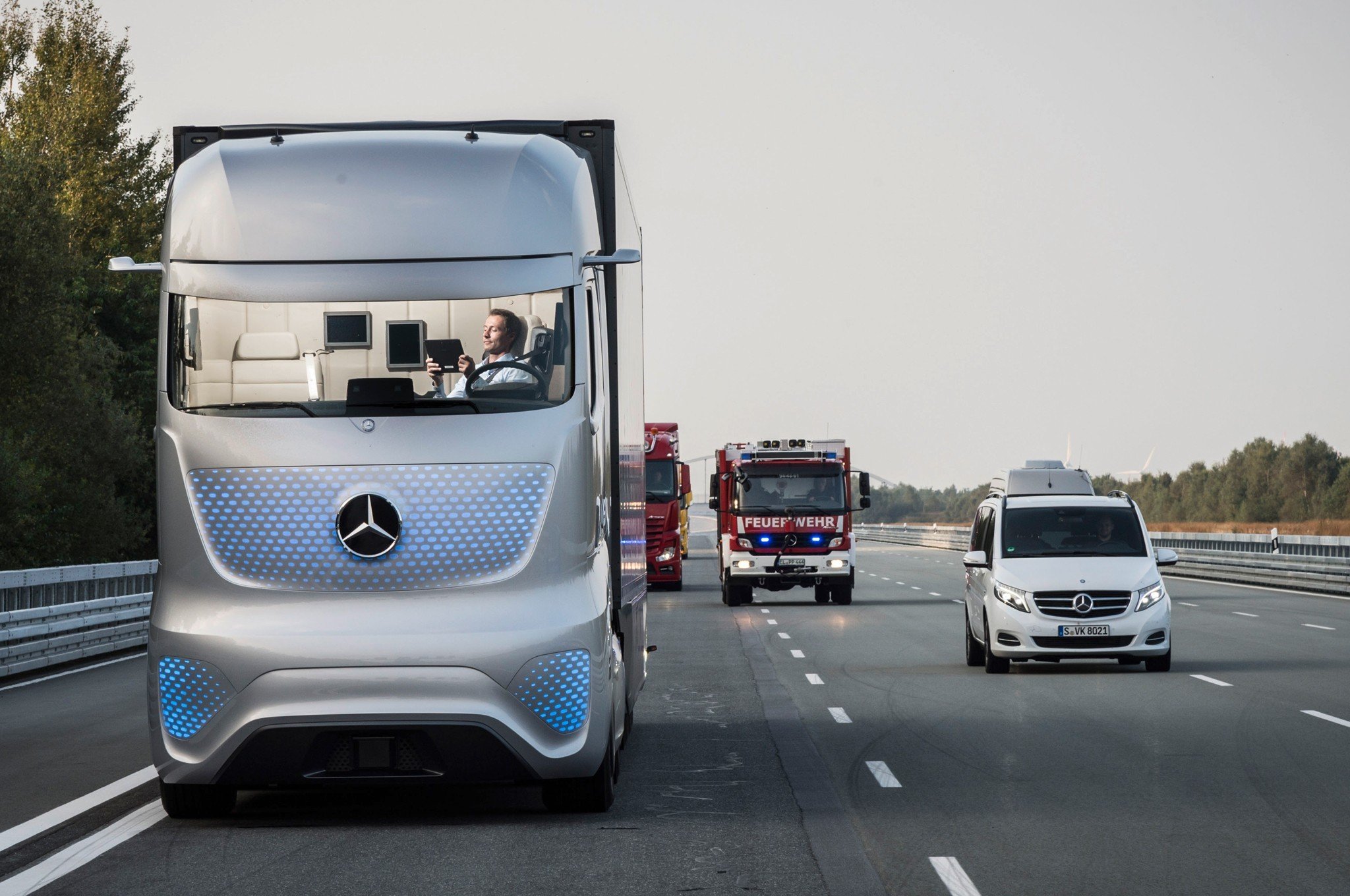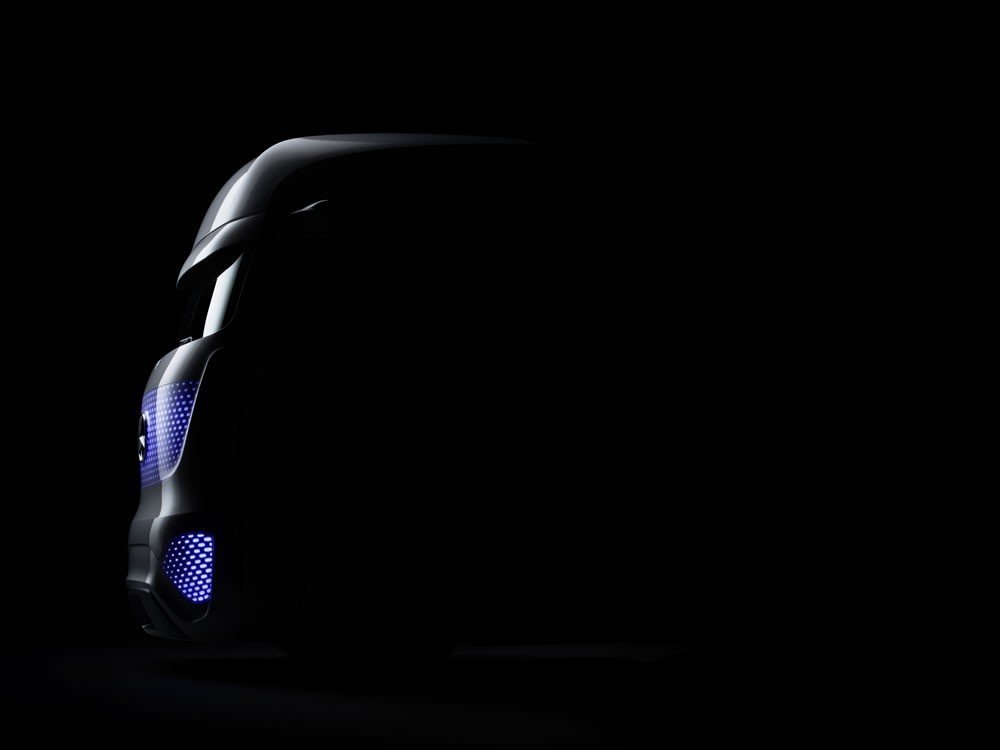
Mercedes-Benz Truck of the Future
The self-steering truck.
There is a revolution taking place, but at a relaxed pace. Calmly and safely, the Mercedes-Benz Future Truck 2025 rolls down the highway at 85 km/h. The tractor and trailer brake and accelerate with precision, riding in the middle of the right-hand lane in flowing traffic. This scene, however, is anything but routine. Though the driver is seated behind the wheel, he is staring at a tablet computer, planning his next trip and then checking the condition of the freight stored on smart pallets in the semitrailer.
The truck is being driven by an automated system called Highway Pilot. The human does the thinking and leaves the driving to the computer.
Vehicle to Vehicle Communication
The near-standard study of an autonomously driven truck demonstrates that the vehicle can also handle special situations without a hitch: The truck automatically pulls into the left-hand lane to allow sufficient room to pass a car broken down on the side of the road. The truck and trailer then pull over to the right a little to allow room for an emergency vehicle approaching from the rear, which announced its presence by exchanging data with the truck.
Especially among smaller vehicles, this process goes by the name of “car-to-car communication” (C2C), but the umbrella term used is vehicle-to-vehicle communication (V2V).
Future technology standards
In the meantime, the driver has found time to reserve a parking spot at the next rest stop, process orders and maintain contacts using a video telephony. Only when the truck leaves the highway does he take the wheel himself and steer the Actros to its destination. With the technologies demonstrated in the Future Truck 2025, Daimler is setting the standard for the future of long-distance transport. “The truck of the future is a Mercedes-Benz and is driverless,” emphasizes Wolfgang Bernhard, member of the Daimler Board of Management and in charge of trucks and buses, at the premiere of the Future Truck in July 2014 on a closed-off section of the Autobahn near Magdeburg, Germany.
“Thanks to this autonomously driving commercial vehicle, we are once again setting the engineering trend for decades to come when it comes to efficiency, safety and connectivity.”
More safety by driver assistance
The Future Truck 2025 provides a taste of developments in commercial vehicle technology in the near future. These innovations will have an impact on business models in the transport industry as well as on the demanding job of a truck driver. With factors such as sustained attention, tight schedules and high traffic density, everyday tasks behind the wheel of a big rig place extreme demands on truckers, as confirmed by Klaus Ruff, Deputy Head of Prevention for the Berufsgenossenschaft für Transport und Verkehrswirtschaft (BG Verkehr – Transport Industry Professional Association) based in Hamburg. The intelligent interlinking of the driver assistance systems down to the automated driving itself contributes significantly to vehicle safety, stressed Ruff.
The truck becomes office
The Future Truck 2025 makes the impact of modern technology tangible. In particular, monotonous long-haul routes lasting hours and hours on major highways, often with tight schedules, could be made easier very soon by trucks that drive themselves. During the trip drivers perform other tasks of considerable value to their companies, including, for example, flexible scheduling of the current trip, planning of upcoming trips and bookkeeping. A truck driver can completely count on the computer systems of his truck, which, thanks to its sensors and exchanging of data with its environment, safely and efficiently heads toward its destination.
“When Highway Pilot is activated, driving becomes a secondary task for the trucker,” confirms Sven Ennerst, Head of Truck Development at Daimler.
The future on the road
Experts agree that autonomous vehicles will soon be reality on the streets – whether driverless fleets of taxis, privately owned cars or commercial vehicles.
Four states in the US – Nevada, Florida, California and Michigan – currently permit operation of autonomous vehicles on public roads under certain conditions. The UK has allowed robotic cars to be used since 2013.
“Fully connected machine with a hive mentality”
Although the Highway Pilot in the Mercedes-Benz Future Truck steers, brakes and accelerates autonomously, the system does not make decisions simply based on information from its own sensors. Instead, the truck acquires a significant amount of information by exchanging data with other vehicles (V2V), with the infrastructure’s stationary communication network (vehicle-to-infrastructure communication or V2I) and by using satellite navigation to determine its position. That is why Stefan Buchner, Head of Mercedes-Benz Trucks, describes the autonomous truck clad in its futuristic adhesive foil disguise, as a “fully connected machine with a hive mentality.”

The fourth industrial revolution
This principle of shared intelligence holds the future of not just the transport industry but industry as a whole, says Sabina Jeschke. The professor at the Department of Computer Science in Mechanical Engineering at the Rheinisch-Westfälische Technische Hochschule (RWTH) in Aachen, places the Future Truck 2025, featured in the “Mobility 4.0″ initiative, on the same level as digitally linked production processes and intralogistics. These kinds of processes, based on the flexible exchange of information between machines, vehicles, warehouses and other elements of industrial process chains, form the backbone of what is referred to as the “fourth industrial revolution.” Even Uwe Clausen, Head of the Fraunhofer Institute for Material Flow and Logistics (IML) in Dortmund stresses that “potential future efficiency does not lie in vehicles alone but in the interplay of vehicles, infrastructure and transport systems."

